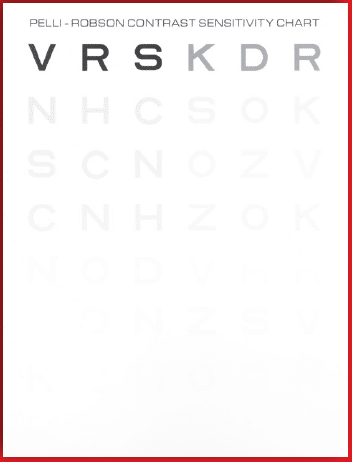
PV News – June 2009 – Rabin Test for Contrast Sensitivity – Precision Vision
IN THE NEWS
With summer upon us, now is the time to seize the opportunity to talk about contrast sensitivity testing with patients, students, colleagues and partners. As we spend more time outdoors during this time of year than any other, we should take a moment to illustrate real-life examples of low-contrast sensitivity and reinforce why testing is paramount (ex: patients with low-contrast sensitivity may not be able to see the pedestrian crossing the road at night). Precision Vision® understands that the interiors of every office, research facility and school are different, which is why the Rabin Contrast Sensitivity Tests we offer come with their own illuminator cabinets, allowing for extremely accurate and reliable testing in any setting. We work with professionals who are undoubtedly recognized as the leading doctors and researchers in our field to ensure the highest quality and value of our products. Precision Vision offers a wide array of contrast tests as standard catalog items and has the capability to manufacture custom products for research and clinical trials. Please visit our Web site or contact us for a free catalog. Please take a moment to read on and call us to find out more about this line of tests available at Precision Vision.
Rabin Test for Contrast Sensitivity Applicable in Multiple Room Settings
In-house study of Rabin Test by top industry contributor validates identical results as Pelli-Robson Test
At one point or another, most of us have uttered the famous idiom, “If it ain’t broke, don’t fix it.” For years in the field of vision testing, the Pelli-Robson test has been the de-facto gold standard of low-contrast sensitivity testing. It has been widely accepted as the tool to turn to when testing for low-contrast sensitivity. However, over the last two years, the Rabin Test has become the preferred product of choice for some practitioners due to its expediency: it can be done in any room setting, versus the Pelli-Robson test, which will only produce accurate results if the room lighting is calibrated precisely to the standard requirements. The main difference between the two tests is that the Pelli-Robson Test uses a single large letter size with contrast varying across groups of letters. It uses six letters per line (three letters per line for each shade of gray), while the Rabin test has five letters at each shade of gray. The five letters at each shade of gray on the Rabin Test is the same as the five letters on a standard ETDRS Visual Acuity Chart, which makes the two more similar. Dr. Ronald Schuchard, director of the Atlanta VA RR&D Center of Excellence, research career scientist at the VA Rehabilitation R&D Service and associate professor of Neurology at Emory University, conducted an in-house comparison between the Rabin and Pelli-Robson tests. The Rabin Test produced the same outcome as the Pelli-Robson test in this unpublished study. “For us, we assumed Pelli-Robson was the gold standard of low-contrast testing. Because the Rabin Test is considered the ‘new kid on the block’, we conducted a series of comparison tests for older adults and low vision subjects and found that it gave us the same results,” said Dr. Schuchard. “We now use the Rabin Test regularly; its biggest advantage is that we can do the testing in a greater variety of room environments.” “Since it comes with its own illuminator cabinet, we do not have to worry if the room lights are properly calibrated. We can take the contrast sensitivity test and do it wherever we want, regardless of what the room light level is. By coupling the chart with a standardized, stand-alone light box, Precision Vision has made it very easy for us to conduct accurate tests,” Schuchard added.
Developed by Jeff Rabin, OD, PhD, U.S. Air Force School of Aerospace Medicine, the Rabin Contrast Sensitivity Tests manufactured by Precision Vision help to detect subtle effects of defocus, low luminance and glare. Each line on the Rabin Contrast Sensitivity Test is a lower contrast than the one before it, using Log CS steps. This progression in contrasts helps to identify the patient’s true contrast sensitivity. While the Pelli-Robson Test doesn’t need “fixing”, leading optometrists and ophthalmologists in the research field have found a better alternative in the Rabin Test for contrast sensitivity, especially due to its convenience. Precision Vision also offers the Rabin Super Vision Test, which is used by the U.S. Armed Forces. This Super Vision test includes visual acuity and letter contrast sensitivity on a single chart. The top portion of the chart tests for visual acuity while the bottom half includes highly calibrated levels of contrast. The chart includes eight separate contrast levels for the most precise contrast sensitivity test. This eye chart also includes a separate optotype sequence for each eye to reduce memorization possibilities, and is designed to be paired with its complementary illuminator cabinet. For more information on the different types of Rabin Tests offered by Precision Vision, please visit our Web site:
PRODUCT PROFILE
Rabin Contrast Sensitivity (CS) Test for the Small 914 Cabinet
Detects subtle effects of defocus, low luminance and glare. 20/50 letter size at 4 meters (13 feet). Log CS increases 0.25 steps per row (0.05 log CS/letter). Includes soft-tipped pointer, recording forms and test instructions. Learn More about this Product Rabin Contrast Sensitivity (CS) Test for the ETDRS Cabinet Notations for testing at 4 meters (13 ft.). Letter size 20M, 4/20,13/66 (6/30, 20/100 equiv). Detects subtle effects of defocus, low luminance and glare. Log CS increases 0.25 steps per row (0.05 Log CS per Letter). This chart is designed for use in the ETDRS Illuminator Cabinet (Cat.No. 2425). Learn More about this Product Rabin Super Vision Test for the Small 914 Cabinet Super vision test is designed for use at 4 meters (13 feet, 1.5 inches). Notations are printed on the chart in LogMAR 0.2 to -0.6 on the top half of the chart. On the bottom half notations are printed in LogCS with a letter size of 5M, 4/5, 13/16.5 (6/7.5, 20/25 equiv.). High contrast VA (20/32 to 20/5 log MAR scale; 20/5 is 4x smaller than 20/20). This chart is designed for use in the Small 914 Illuminator Cabinet. Learn More about this Product Pelli-Robson SLOAN Letter Contrast Chart Features Traditional Sloan Optotypes. For use at 40 in (1m). Includes two charts and two scoring pads. Illumination of 85 cd/m² is key to good results. The chart follows the luminance, font, and letter spacing recommendations of the Committee on Vision of the National Academy of Sciences and National Research Council (Adv. Ophthal 41, 103-148, 1980). Learn More about this Product Mars Letter Contrast Sensitivity Test Establishing baseline contrast sensitivity prior to and after an intervention. Three charts, for the left eye, right eye and binocular testing, or for repeated testing without letter sequence memorization. Rapid administration, with easy, accurate scoring. Easy to illuminate (e.g., with instrument stand lamp). Each chart mounted on durable plastic. Designed for near testing (40 or 50 cm). Learn More about this Product
SEE PV
Upcoming Events – Tradeshows
You can find Precision Vision exhibiting at the following events: NASN – June 25-26 in Boston, MA at Booth 503
Share Your Stories With Us!
Precision Vision® wants to hear your stories. Tell us how you are impacting the industry. Do you have an interesting story to share about a Precision Vision® product? Contact us and we may use it in a future newsletter.





